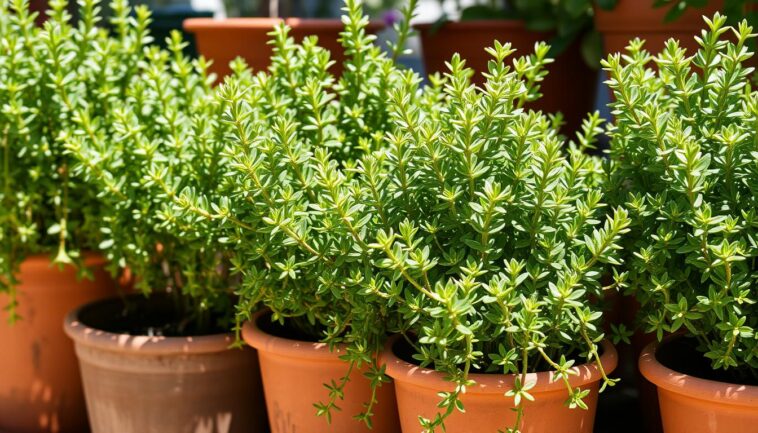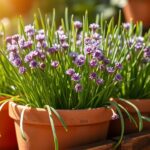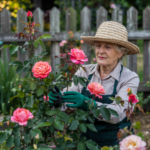Gardening in small spaces is easy. This guide will show you how to grow and care for thyme in pots. It’s perfect for anyone, whether you’re new to gardening or have been doing it for years.
Thyme is a Mediterranean herb that loves containers. It gives off a lovely scent and attracts bees and butterflies. Its roots don’t need much room, making it great for small spaces like patios or kitchen windows.
In this guide, we’ll talk about the sun, soil, and water your thyme needs. With the right care, you’ll have fresh thyme all year. Let’s get started on growing thyme in pots like a pro.
Why I Love Growing Thyme in Containers
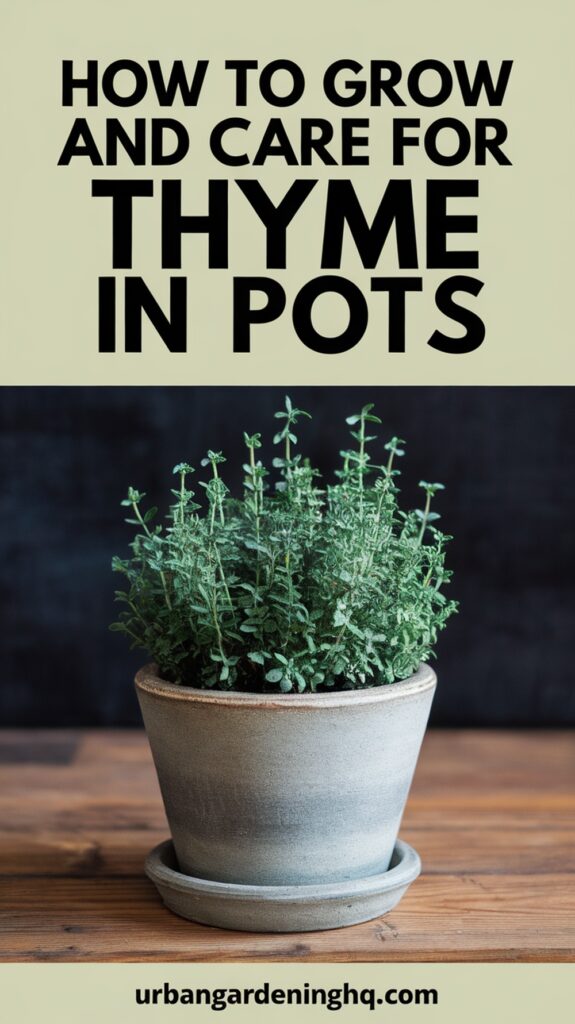
Five years ago, I found out thyme loves containers. It’s now a key part of my herb garden. Taking care of thyme in containers is easy. It gives you a fragrant, useful herb that can go anywhere.
Its roots don’t need much room, making it perfect for small pots. Just 6 inches deep and 12 inches wide is enough. It’s great for patios, kitchen windowsills, or balcony gardens.
- Mobility: I move my pots to follow the sun or protect plants from frost, ensuring year-round growth.
- Space-saving: Even in tight spaces, thyme grows 3–12 inches tall, filling containers without overcrowding.
- Low maintenance: Drought-tolerant and unfussy about soil, it prospers in sandy mixes, needing only occasional watering.
Thyme container care also makes it look beautiful. The tiny pink or purple flowers add color. Pruning helps it grow bushy.
I harvest sprigs often, using scissors for cooking. This keeps plants tidy and productive. Unlike other herbs, thyme doesn’t need rich soil. It also looks great with rosemary or lavender in mixed containers.
Whether you’re new to gardening or have experience, thyme is a great choice for containers. My favorite thing? Seeing it cascade over pots, adding Mediterranean charm to any spot.
Choosing the Perfect Pot for Your Thyme Plants
Finding the right container is essential for thyme to thrive. I’ve learned that terra cotta pots are the best. They let air in, which is great for thyme’s growth.
Terra Cotta vs. Plastic Containers
Clay pots are my top pick. They let moisture out, keeping roots dry, which thyme loves. Plastic pots are cheaper but can hold too much water. Make sure they have holes for drainage.
Stay away from metal pots unless they’re in the shade. They can get too hot. Eco-friendly growers might like biodegradable pots, but they might need to be replaced every year.
Ideal Pot Size for Healthy Thyme
Thyme needs room to grow but not too much. A 6-inch deep, 12-inch wide pot is perfect for one plant. For more plants, choose a 24-inch pot and space them 12 inches apart.
Shallow-rooted thyme does well in 8-inch pots. But spreading types need wider ones. Increase the pot size by 2 inches every time the plant grows to prevent it from getting too crowded.
Ensuring Proper Drainage
Drainage is key. Every pot needs holes, with larger pots needing 3-4. Here’s how I set it up:
- Layer broken pottery or gravel at the bottom to block holes from clogging
- Use a mix of potting soil, sand, and perlite for light, airy soil
- Elevate pots with pot feet to stop water pooling at the base
Don’t use heavy soil mixes that hold water. Thyme dies faster from too much water than too little. These tips help keep thyme’s roots healthy.
The Best Soil Mix for Container-Grown Thyme
Container gardening thyme care begins with the right soil mix. Over the years, I’ve found thyme loves a mix that drains well. My favorite mix includes organic potting soil, coarse sand, perlite, and compost. It’s like the Mediterranean soil thyme adores, keeping roots dry and healthy.
Stay away from heavy garden soil. It can cause pots to compact and lead to root rot. Here’s what I use:
| Component | Percentage |
|---|---|
| Organic potting soil | 30-40% |
| Coarse sand or horticultural grit | 40-50% |
| Perlite or pumice | 10-15% |
| Well-rotted compost | 10% |
I check the pH every year to keep it between 6.0-7.5. This range is perfect for thyme to grow strong. If the soil is too rich, thyme becomes leggy and less tasty. The mix is naturally lean on nutrients, which thyme loves.
To add a touch, I sprinkle decorative gravel on top. It looks nice and keeps the soil dry, reducing disease. This thyme pot care guide keeps plants healthy with minimal effort. With the right soil, your container garden will flourish with this fragrant herb.
How to Grow and Care for Thyme in Pots: My Complete System
My system for growing thyme combines Best practices for growing Thyme in pots with Thyme care essentials. This ensures my plants are lush and thriving. Here’s how I start and maintain my thyme collection every year.

Starting seeds is slow but rewarding. I sow them indoors 8-10 weeks before the last frost. Here’s my method:
- Use seed trays filled with seed-starting mix
- Scatter seeds thinly on the surface and cover with a light layer of vermiculite
- Maintain 70°F soil temperature with a heat mat if needed
- Mist daily to keep soil moist until sprouts appear in 12-15 days
For quicker results, I propagate cuttings in late spring. My steps:
- Cut 3-4 inch stem tips with no flowers
- Dip cut ends in rooting hormone powder
- Plant in 50/50 perlite and coco coir mix
- Cover with a plastic bag to retain humidity
- Transplant once roots form in 2-3 weeks
When buying nursery plants, I always check roots first. My transplant process:
- Unpot the plant and tease out tangled roots
- Trim circling roots to encourage outward growth
- Plant at the same soil level as the original pot
- Clip the top by 1/3 to encourage branching
Combining these methods ensures a steady supply of thyme for cooking or landscaping. Every plant follows these steps to maintain consistent health and flavor.
Sunlight Requirements for Thriving Potted Thyme
Thyme loves lots of sunlight, a key part of how to grow and care for thyme in pots. As a Mediterranean herb, it needs 6–8 hours of direct sun each day. Without enough light, it grows leggy and tastes weak. My plants do best in full sun, so where you place them matters.
Indoor Lighting Options
- Position plants within 1 foot of a south-facing window for maximum natural light.
- Supplement with full-spectrum LED grow lights (15+ DLI) for 12–14 hours daily if light is low.
- Avoid fluorescent lights—they lack the intensity needed for robust growth.
Outdoor Placement Tips
- Choose spots with morning sun and afternoon shade in zones with temps above 95°F.
- Rotate pots weekly to ensure even growth toward light sources.
- Place containers near south-facing walls in colder zones to boost warmth and light exposure.
Thyme growing tips stress consistency: adjust placement based on your climate. My plants thrive when I prioritize light intensity and duration, ensuring their Mediterranean roots are met.
Watering Techniques That Keep Thyme Happy

Thyme in containers loves to be ignored. This Mediterranean herb grew in dry lands. So, let the top inch of soil dry before watering. Too much water causes root rot and yellow leaves.
Here’s my system:
- Feel the soil with your finger—water only when it’s bone-dry 1–2 inches deep
- Use Miracle-Gro® Performance Organics® All Purpose Container Mix to boost drainage
- Bottom-water by soaking pots in a tray for 30 minutes weekly during active growth
- Self-watering pots with reservoirs help prevent overwatering in small spaces
- Winter care: Water just enough to keep roots from shriveling, every 3-4 weeks
Container gardening Thyme care needs a balance. Let roots dry between drinks. This hardy herb thrives with consistent, careful watering. Weekly checks with your finger can prevent 90% of common problems. Follow these steps, and your thyme will stay green and healthy.
Fertilizing Container-Grown Thyme Without Overwhelming It
In the Thyme pot care guide, a key rule is: less is more. My thyme plants do best with a light touch. Too much fertilizer weakens their taste and can cause damage.
I stick to organic options for my thyme. In the spring, I add a ½-inch compost layer. For liquid feed, I mix seaweed extract at ¼ the recommended strength. This provides essential nutrients without overfeeding.
Here’s my Thyme container care plan:
1. Early spring: Apply compost layer.
2. Midsummer (if heavily harvested): Optional light compost boost.
3. Every 6–8 weeks in growing season: Use diluted seaweed solution.
4. Stop all feeding by September to let plants harden off.
Stay away from synthetic fertilizers. They make thyme tasteless and stems stretchy. My thyme’s scent is at its best when I follow this simple care routine. It shows that a little care goes a long way in growing great herbs.
Pruning and Maintaining Potted Thyme for Bushier Growth
Pruning is key to keeping thyme lush and productive. My Thyme growing tips cover timing and technique for a bushy, flavorful plant. We’ll explore how to keep your plant healthy without overworking it.

When and How to Prune
Begin pruning in early spring by cutting back damaged stems. Use clean shears to remove one-third of the plant’s height, cutting just above leaf nodes. For a harvest-focused approach, trim stems during active growth phases. Avoid heavy cuts after August to protect winter hardiness.
Preventing Woody Stems
Prevent leggy growth by harvesting frequently—snip sprigs before flowering to redirect energy to leaves. Follow these steps for rejuvenation:
- Every 1–2 years in spring, repot into a slightly larger container with fresh soil, trimming roots by a third.
- In late fall, cut back one-third of the oldest stems to the base to stimulate new shoots.
- In summer, remove spent flowers to stop energy waste on seeds.
Never let plants older than three years go unchecked—replace overly woody specimens with cuttings from healthy growth. Pruning isn’t just about shape; it’s about longevity. With consistent care, your potted thyme will thrive for years.
Common Pests and Diseases in Container Thyme (And My Solutions)
Pests and diseases can be tough on even the best Thyme growers. Aphids and spider mites are common pests. Root rot is a major disease I’ve dealt with. Here’s how I tackle each problem:
Pests to Watch For:
- Aphids: Blast them off with a hose or mix 1 tbsp castile soap in 1 quart water. Repeat every 3 days.
- Spider Mites: Misting plants daily and wiping leaves with neem oil helps. Remove heavily infested leaves.
- Scale Insects: Dab with rubbing alcohol then coat with horticultural oil.
Disease Solutions Table:
| Problem | Symptoms | Fix |
|---|---|---|
| Powdery Mildew | White powdery coating on leaves | Mix 1 tsp baking soda + 1 tbsp milk in 1 quart water. Spray weekly. |
| Root Rot | Yellowing leaves, mushy stems | Trim rotted roots, dust with cinnamon, repot in fresh soil. |
Thyme care essentials include weekly inspections and quick action. I avoid overwatering—let soil dry between waterings. For prevention:
- Space plants to allow airflow
- Use pots with drainage holes
- Apply neem oil monthly as a preventive spray
Early detection is key. I check plants daily during high-risk seasons. When issues arise, addressing them fast keeps my thyme thriving year-round.
Harvesting and Using Your Homegrown Thyme
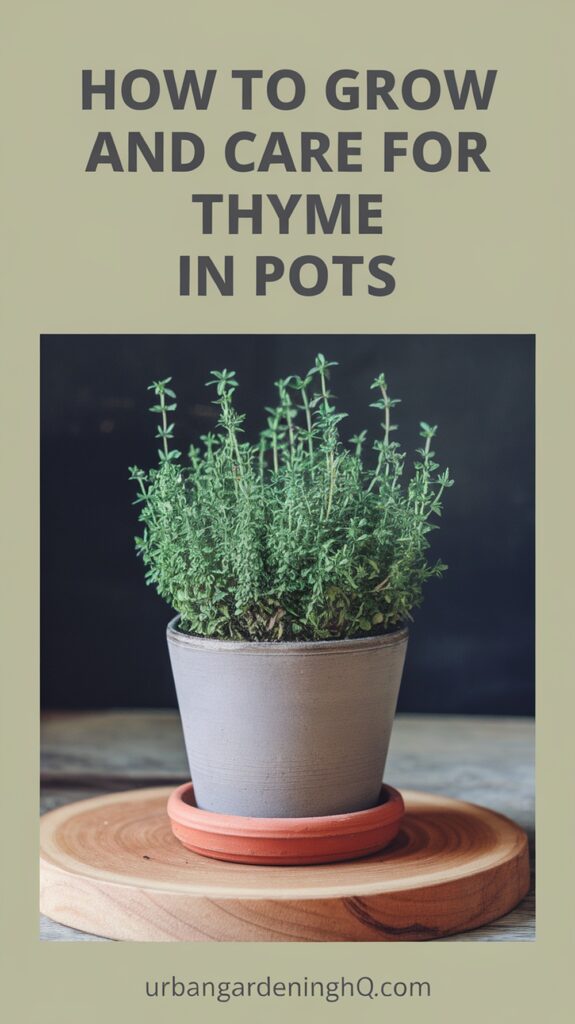
When your thyme plants grow well, it’s time to enjoy the fruits of your labor. Regularly picking thyme helps it grow bushy and full. This way, you get lots of fresh, fragrant leaves. Here’s how I make the most of every sprig.
Best Time to Harvest
I pick stems just before they flower in early summer. This is when the oils are at their best. Harvesting in the morning gives you the most flavor. Just make sure to leave half the plant to grow back.
Use clean scissors to cut 5–6 inches from the top. Make cuts above leaf nodes to help the plant branch out.
Preserving Methods for Maximum Flavor
To keep thyme fresh, I store cut sprigs in a jar of water or wrap them in a damp cloth. For longer storage:
- Air-dry: Hang small bunches upside-down in a warm, dark spot. Once dry, store leaves in glass jars.
- Freeze: Chop leaves and pack into ice cube trays with water or olive oil.
- Infuse: Tuck sprigs into honey or salt for seasoning blends that last months.
My Favorite Culinary Uses
Fresh thyme makes roasted veggies and stews taste amazing. I sprinkle leaves over carrots or mix into butter for garlic bread. Lemon thyme adds a bright flavor to fish dishes.
Dried leaves add depth to homemade soups. Even the flowers are great in herb butters or teas. For a special touch, I steep sprigs in honey for drizzling over yogurt or veggies.
Seasonal Care Tips: Helping Your Potted Thyme Thrive Year-Round
Seasonal changes require smart adjustments to keep potted thyme thriving. My thyme pot care guide focuses on adapting techniques for every season’s demands. Here’s how I manage each phase:
- Spring: Trim dead stems and apply a thin layer of compost. Repot root-bound plants using sandy, well-draining soil to prevent root rot.
- Summer: Provide morning sun but shade plants from intense afternoon heat with a cloth. Water deeply but infrequently, letting soil dry completely between sessions.
- Fall: Reduce watering as growth slows. Stop pruning after September to avoid stimulating new growth that frost might damage.
- Winter: Move pots to a sunroom or south-facing window. Wrap pots with bubble wrap if staying outdoors. Water sparingly—once every 3-4 weeks—to avoid overwatering.
Year-round basics include testing soil annually for drainage and alkalinity. Use neem oil for pests and encourage beneficial insects like ladybugs. My thyme potting techniques prioritize soil dryness in winter and light exposure in all seasons. With these adjustments, your thyme stays lush whether it’s bundled indoors or braving frost outdoors.
Conclusion: Enjoying the Rewards of Your Potted Thyme Garden
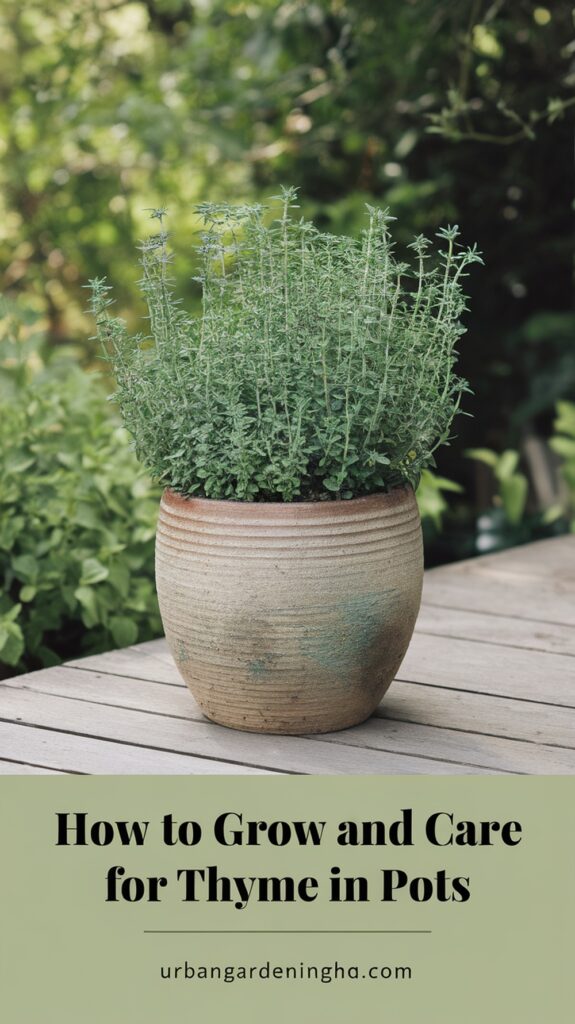
Watching my potted thyme grow has shown me the joy of container gardening. By following the right tips, you can grow a hardy herb that’s as versatile as it is fragrant. Its leaves add a Mediterranean flavor to dishes, and it fits well on sunny windowsills or balconies.
Thyme is tough and can handle neglect, making it great for busy people. When you pick fresh sprigs for cooking, you’ll see why it’s a kitchen favorite. Its ability to thrive in small spaces and its drought-resistant nature make it stand out.
With the right soil and sunlight, thyme becomes a valuable kitchen tool and a beautiful addition to your space. Try different varieties like lemon or silver thyme for more color and flavor. Every time you use it, you’ll remember that even small pots can bring big happiness.
